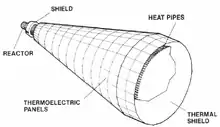SP-100
SP-100 (Space reactor Prototype[1]) was a U.S. research program for nuclear fission reactors usable as small fission power systems for spacecraft. It was started in 1983 by NASA, the US Department of Energy and other agencies.[2]

SP-100 nuclear power system
A reactor was developed with heat pipes transporting the heat to thermionic converters. It was cooled with lithium.[3] The project never advanced to flight hardware and was terminated in 1994.[4]
See also
- Systems Nuclear Auxiliary Power Program and SNAP-10A, that flew in 1965
- Safe Affordable Fission Engine, a later project
- Kilopower, a later small space reactor
References
- Acronyms: SP-100 means Space reactor prototype
- SP-100, the US Space Nuclear Reactor Power Program, Technical information report. Available at Energy Citations Database
- Stănculescu, Adrian (2005). The Role of Nuclear Power and Nuclear Propulsion in the Peaceful Exploration (PDF). Vienna: International Atomic Energy Agency. pp. 21–22. ISBN 92-0-107404-2. Retrieved 2009-02-24.
-
Mason, Lee; Bailey, Sterling; Bechtel, Ryan; Elliott, John; Fleurial, Jean-Pierre; Houts, Mike; Kapernick, Rick; Lipinski, Ron; MacPherson, Duncan; Moreno, Tom; Nesmith, Bill; Poston, Dave; Qualls, Lou; Radel, Ross; Weitzberg, Abraham; Werner, Jim (18 November 2010). "Small Fission Power System Feasibility Study — Final Report". NASA/DOE. Retrieved 3 October 2015.
The SP-100 program objective was to develop the technologies needed for a broad range of space missions requiring a high power-to-weight ratio with nominal 100 kWe power output. The program began in 1982 and was terminated by Congress in 1994. A high temperature (1350 K) refractory alloy heat transport system with thermoelectric power conversion was designed, uranium nitride fuel was fabricated and irradiated to 6% burnup, and significant amounts of hardware and electronics were successfully tested.
This article is issued from Wikipedia. The text is licensed under Creative Commons - Attribution - Sharealike. Additional terms may apply for the media files.